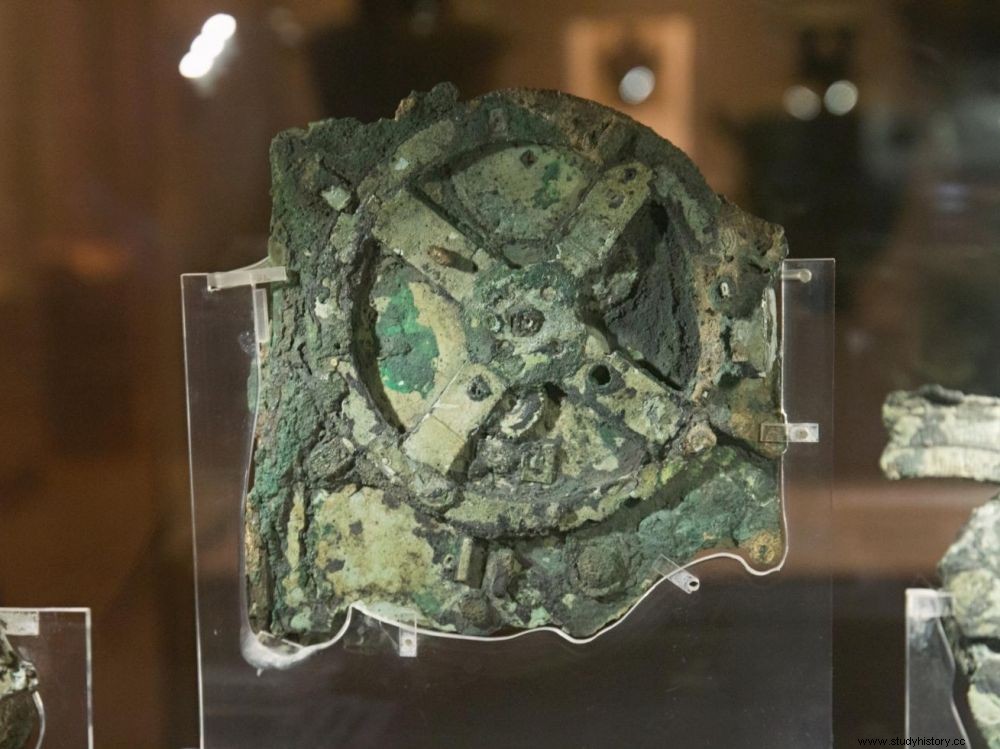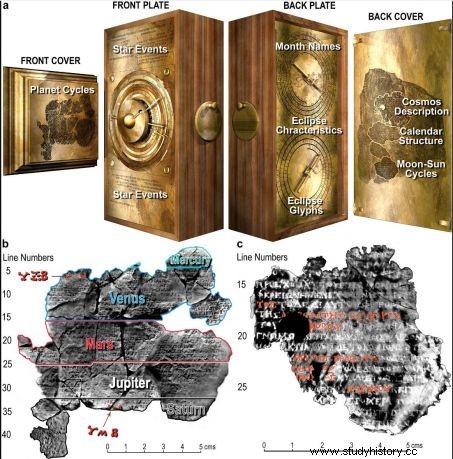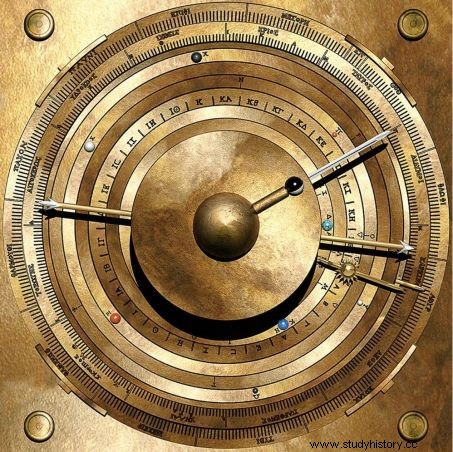A team of researchers from the University College of London (UCL) has just proposed the most advanced digital reconstruction to date of the famous Antikythera machine, a small machine from ancient Greece which would have served as an astronomical position calculator. A daring work, but which nevertheless remains "highly speculative".

The Antikythera mechanism or machine, a small object dating from around the 1st century BC, is said to have been used to calculate the positions of the Moon and the Sun. Very incomplete, it remains very mysterious today, in particular for its anachronistic character.
Housed in the National Archaeological Museum of Athens, the Antikythera Machine, supposedly designed around the 1st century BC to calculate astronomical positions, is considered the oldest known gear mechanism in the world. It is also, and above all, one of the most mysterious and controversial scientific artifacts. Of this strange bronze contraption, we only know of a single specimen:the very one, found in the wreck of a Roman galley in 1901 by sponge fishermen off the Greek island of southern Peloponnese Antikythera.
A "virtuoso" object that is debating
If the uniqueness of an object can be considered a problem for archaeologists (the fact of not finding other examples always makes it difficult to locate and contextualize), the Antikythera machine has another characteristic that makes it makes it even more ambiguous:she is an engineering marvel. The complexity of its mechanisms is so dazzling that some historians even refuse to believe that such a device was made so early in history. The dating of the galley, estimated as prior to 87 BC, has made it possible to set a minimum age limit for the Antikythera machine. But even today, there is no consensus on the time of its conception:some researchers place it between the end of the 3rd and the middle of the second century BC (Giovanni Pastore, 2010), others at a a slightly more recent period, between the 2nd and 1st centuries BC. Just 20 centimeters high, it includes dozens of cogwheels articulated together on several planes, and engravings of disconcerting finesse. It will be necessary to wait until the 17th century to see the emergence of such watchmaking technicality in the West!
But the gray areas do not stop there:the small device is unfortunately very incomplete. Only damaged pieces remain - in 82 fragments -, which would correspond to only a third of the complete machine. This is one of the reasons why its function has been debated for so long. Today, archaeologists, engineers and historians of science agree that the device was an astronomical calendar used to calculate the positions of the Moon and the Sun. It's already that.
Speculation
We therefore understand that the machine is an enigma that is not close to being solved.
Preserved in the National Archaeological Museum of Athens, the Antikythera machine, supposedly designed around the 1 st century BC for calculating astronomical positions, is considered the oldest known gear mechanism in the world. It is also, and above all, one of the most mysterious and controversial scientific artifacts. Of this strange bronze contraption, we only know of a single specimen:the very one, found in the wreck of a Roman galley in 1901 by sponge fishermen off the Greek island of southern Peloponnese Antikythera.
A "virtuoso" object that is debating
If the uniqueness of an object can be considered a problem for archaeologists (the fact of not finding other examples always makes it difficult to locate and contextualize), the Antikythera machine has another characteristic that makes it makes it even more ambiguous:she is an engineering marvel. The complexity of its mechanisms is so dazzling that some historians even refuse to believe that such a device was made so early in history. The dating of the galley, estimated as prior to 87 BC, has made it possible to set a minimum age limit for the Antikythera machine. But even today, there is no consensus on the time of its conception:some researchers place it between the end of the 3rd and the middle of the second century BC (Giovanni Pastore, 2010), others at a a slightly more recent period, between the 2nd and 1st centuries BC. Just 20 centimeters high, it includes dozens of cogwheels articulated together on several planes, and engravings of disconcerting finesse. It will be necessary to wait until the 17th century to see the emergence of such watchmaking technicality in the West!
But the gray areas do not stop there:the small device is unfortunately very incomplete. Only damaged pieces remain - in 82 fragments -, which would correspond to only a third of the complete machine. This is one of the reasons why its function has been debated for so long. Today, archaeologists, engineers and historians of science agree that the device was an astronomical calendar used to calculate the positions of the Moon and the Sun. It's already that.
Speculation
We therefore understand that the machine is an enigma that is not close to being solved. But these many question marks haven't stopped a team at the University College of London from embarking on a full reconstruction of the device. Their work is published on March 12, 2021 in the journal Scientific Reports . "(…) No previous reconstruction has managed to approach the data. Our findings lead to a new model, which satisfies and explains the evidence. Solving this complex 3D puzzle reveals a genius creation - combining the cycles of Babylonian astronomy, the mathematics of Plato's Academy and the astronomical theories of ancient Greece" , write the researchers in the preamble to their study. Among them, the mathematician and engineer Tony Freeth, a great enthusiast of the machine (he notably set up a production company to devote a documentary to it).

Here is an overview of the reordered fragments. In (b), the engraved mentions of the planets Mercury, Venus, Mars or Jupiter. Credits:Tony Freeth/UCL
What exactly did Tony Freeth and his team do? A digital reconstruction of the device from X-ray tomography scans previously taken by fellow Antikythera enthusiast, mechanical engineering professor and museum curator Michael Wright. The latter has also, in the past, offered a replica of the machine, although it was incomplete. But Tony Freeth's reconstruction relies on a third source of data:the astronomical calculations of the ancient Greek philosopher Parmenides, so that the mathematical basis is that of postulates from ancient Greece (namely, the idea that everything revolves around of the Earth, not the Sun). "Parmenides, a pre-Socratic philosopher about whom we know almost nothing with certainty" , comments Denis Savoie, science historian for Universciences and the Paris Observatory. "I don't know why relying on the supposed work of this Greek scholar, it seems to me a funny idea." For this expert familiar with the Antikythera machine, the work of Freeth and his team is “highly” speculative. " They offer a machine even more brilliant than one would have dared to imagine, even though the fragments we have are still debated."
Planets mentioned but no evidence for a planetary mechanism
In its suggested digital model, Tony Freeth's team does not hesitate to imagine another mechanism that would have "clipped" on the main part of the machine. This would have made it possible to calculate the positions of the planets of the Solar System, mentioned in inscriptions in Greek deciphered on the machine. " We wanted to determine the cycles of all the planets in this cosmos (not just the cycles discovered for Venus and Saturn), incorporate those cycles into very compact mechanisms, consistent with physical evidence, and intertwine them in such a way that their outputs correspond to the usual cosmological order (...)" , explain the researchers. Denis Savoie admits that he still struggles to understand the justification for such a result:" Apart from admitting that they are here in an exercise in style. James Evans, who has also worked extensively on this machine, has indeed put forward the seductive idea that a planetary mechanism may have been complementary to that of the positions of the Moon and the Sun, but this is only so far. 'a suggestion."

The dial displaying the positions of the planets as imagined by the UCL team. Credits:Tony Freeth/UCL
"Our work reveals that the Antikythera Mechanism stems from a magnificent design, whose superb engineering results in a genius device. It challenges all our preconceptions about the technological capabilities of the ancient Greeks" , concludes the team. It is obvious that the Antikythera mechanism shakes our knowledge of what the ancient Greeks had in mathematics and especially in engineering. But there is still a long way to go before attributing to these same Greeks the paternity of an object that even the Italian doctor and clockmaker Giovanni Dondi, to whom we owe the incredible Astrarium (the combination of a clock astronomical and a planetarium developed between 1348 and 1364), could not have conceived.
